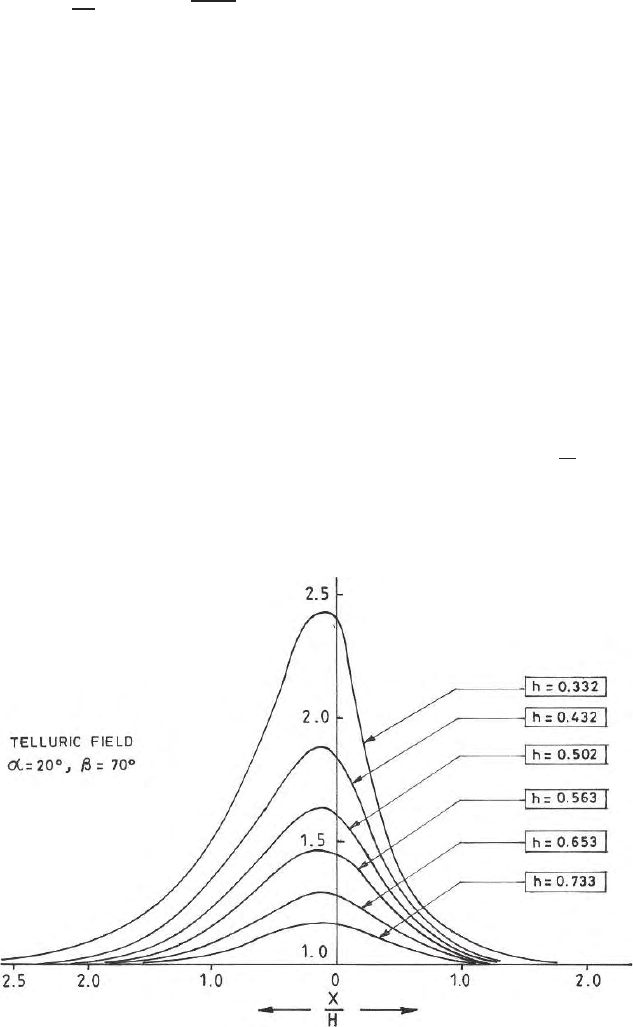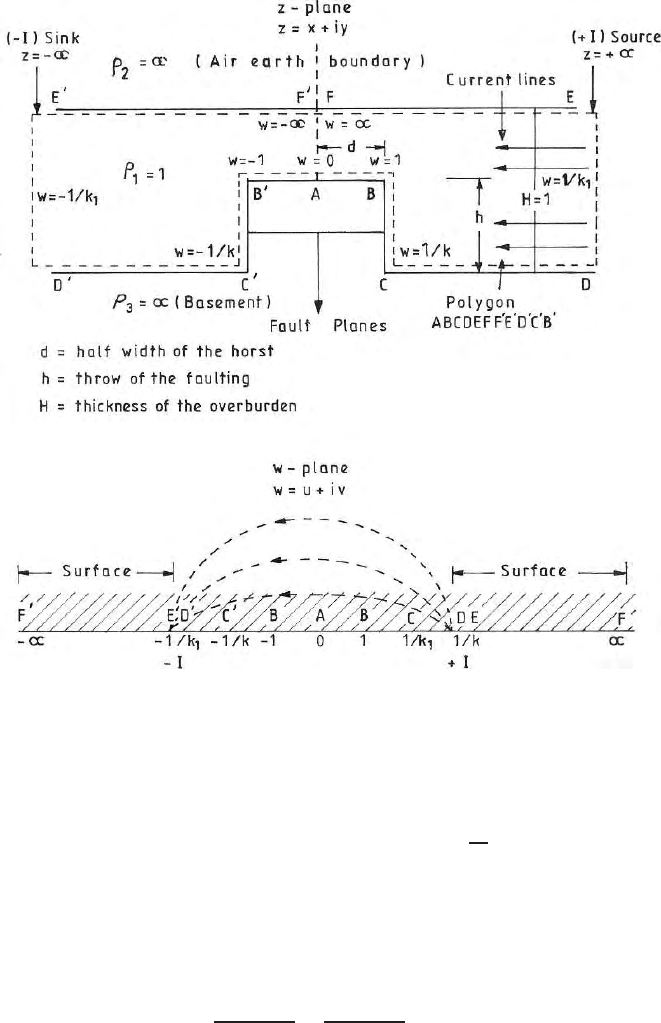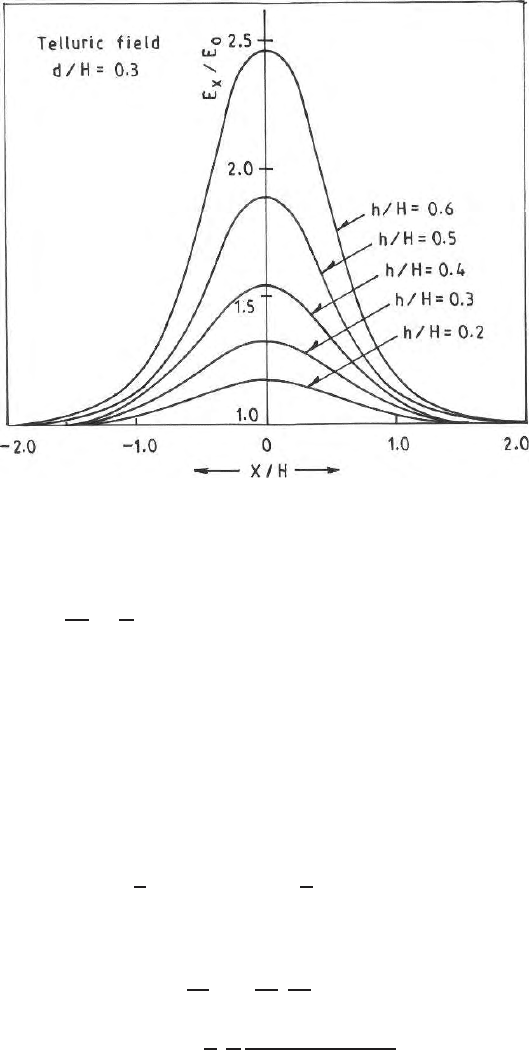Roy K.K. Potential theory in applied geophysics
Подождите немного. Документ загружается.


9.6 Geophysical Problems on S-C Transformation 289
In principle, (9.118) and (9.119) can now b e used to solve for ‘k’ and ‘l’
uniquely. For solution of the problem values of ‘k’ and ‘l’ satisfying (9.118)
and (9.119) are selected and ‘h’, for which (9.104) is satisfied, is determined.
By varying ‘k’ ‘l’ , ‘h’ can be varied; however, this method is not particularly
convenient if it is desired to vary h in regular steps. It may be n oted that
(9.118) and (9.119) are non-linear and can be solved only numerically. The
Runge-Kutta method of order four was used. Figure 9.11c shows the trajectory
of the path in the W-plane as the point moves from A (Fig. 9.11a) to the
epicentre of the point A on the surface. It is needed for point to point mapping.
Computation of Telluric Field and Apparent Resistivity
Having transformed the complex geometry of the problem into a simple one,
the field problem in the w-plane is solved first and then it is transferred
onto the z-plane. The telluric field in the z-plane may be looked upon as
that due to a point source and a point sink placed at ±∞ respectively. After
transformation the point source at +∞ is mapped onto DD
′
while the sink is
still at infinity. The boundary conditions in the w-plane are: Potential gradient
across the real axis is zero and the pot ential goes to zero on the semicircle
with infinite radius in the upper half of the w-plane. The potential due to
a po int sour ce, satisfying the above boundary conditions and the Laplace’s
equation is
φ =
I
π
ln
1
w − 1
. (9.120)
The gradient is transferred to the z-plane and the field equation is
E=−
dφ
dz
= −
dφ
dw
dw
dz
=
I
π
A
−1
1
(w)
−(α+β)
π
(w + k)
α/π
(w − ℓ)
β/π
. (9.121)
Since the telluric field is measured on the earth’s surface (where y = 0 and
v = 0), (9.121) may further be simplified to
E=−
dφ
dx
=
I
π
A
−1
1
(u)
−(α+β)
π
(u + k)
α/π
(u − ℓ)
β/π
. (9.122)
To determine the telluric field at a given point on the x-axis, the map of x on
the u axis is computed and then (9.122) is evaluated taking point by p oint
mapping. From (9.120) we can write the telluric field as
E=−
dφ
dw
=
I
π
1
w − 1
. (9.123)
The (9.105) changes to
dx
du
=A
1
(u)
−α+β
π
α/π
(u − ℓ)
β/π
(u − 1)
−1
(9.124)
for the purpose of mapping on the real axis. Taking its inverse the equation is

290 9 Complex Variables and Conformal Transformation in Poten tial Theory
du
dx
=A
−1
1
(u)
−(α+β)
π
(u + k)
α/π
(u − ℓ)
β/π
(u − 1)
−1
(9.125)
which may be considered as a non-linear differential equation connecting u and
x. By integrating (9.118) and (9.119) numerically with the initial condition,
viz. u = u
0
at x = 0 which was determined earlier, a map of any p oint on the
real x-axis is obtained. Figure 9.10d shows the telluric field response over an
anticlinal structure.
9.6.4 Problem 4 Telluric Field Over a Faulted Basement (Horst)
In this section a problem is pr esented where closed form solution is obtained
and conformal transformation is used along with elliptic integrals and elliptic
functions. For the benefit of the readers a brief outline of the elliptic integrals
and elliptic functions are given in Sect. 9.7. (Roy 1973).
A two dimensional model of the horst is shown in (Fig. 9.12 a, b). In this
section a rectangular basement structure is chosen. As in the previous case
it is assumed tha t the resistivity ‘ρ’ and the thickness ‘H’ of the sedimentary
layer are both unity. ‘h’ and ‘d’ are respectively the throw of the fault and
half width of the horst. In the z-plane the source and sink are assumed to
be at ±∞ so that in the w-plane they are mapped at DE (w =
1
k
1
)andat
D
′
E
′
(w = −1/k
1
) respectively.
Since the basement is assumed to be of infinite resistivity, the problem
reduces to a Neumann problem, i.e., th e potential should satisfy Laplace’s
(d)
Fig. 9.11. (d)Telluric field anomaly over an asymmetric anticline

9.6 Geophysical Problems on S-C Transformation 291
Fig. 9.12 a, b. Show the faulted basement with h orst type of structure in the Z-
plane and its map on the real axis of the W-plane; map of surface and subsurface
onto the real axis of the w-plane ; flow of direct current from infinity; long line source
and sink placed at infinite distance away in the z-plane and are respectively mapped
at DE and E’D’ on the real axis
equation with the condition that the normal gradient
∂φ
∂n
= 0 throughout the
entire boundary FEDCBA B
′
C
′
D
′
E
′
F
′
. A two dimensional potential distribu-
tion in a homogeneous isotropic and in a source free region is given by the
Laplace’s equation.
Closed form mathematical solution can be obtained using conformal trans-
formation and elliptic integrals and functio n. These problems satisfy Laplace
equation
∂
2
φ (x, y)
∂x
2
+
∂
2
φ (x, y)
∂y
2
=0. (9.126)

292 9 Complex Variables and Conformal Transformation in Poten tial Theory
Using the method of Schwarz – Christoffel transformation. The transformation
function for the present problem may be expressed in the differential form as
dz
dw
=A (w −1)
1/2
(w − a)
−1/2
(w −b)
−1
(w + 1)
1/2
(w + a)
−1/2
(w + b)
−1
=A
w
2
− 1
1/2
(w
2
− a
2
)
1/2
(w
2
− b
2
)
(9.127)
z =A
w
0
w
2
− 1
1/2
dw
(w
2
− a
2
)
1/2
(w
2
− b
2
)
+ C
1
. (9.128)
Here C
1
= 0, b ecause the origin in the z-plane is fixed. Equation (9.128)
is in the form of an elliptic integral. The above integral is brought into a
standard form by substituting a = 1/kandb=1/k
1
(Kober 1957) and
Byrd Friedman (1954). In the next section, an introductory level discussion
on elliptic integrals and elliptic functions are given. For better background,
the readers will have to read the standard text books on elliptic integrals and
functions. Equation (9.128) therefore reduces to
or
z=C
w
0
1 −w
2
1/2
dw
(1 −k
2
w
2
)
1/2
(1 −k
2
1
w
2
)
(9.129)
where C = −k
2
1
A
k
is a new constant. Hence the values of C, k and k
1
are to
be known before solving the boundary value problem. In order to evaluate
the constant C the following boundary condition is applied. It is noted from
(9.129) that at the p oint w = 1/k
1
an algebraic singularity is present. There-
fore, (9.129) is integrated around an infinitesimal semicircle from w =
1
k
1
+ ε
to w =
1
k
1
− ε where ε → 0 and thus the singular point is avoided. However,
the approach is different from that shown in the previous problem. Since the
shift in the z-plane is ‘iH’ the (9.129) can be written as :
iH = C
1 −1/k
2
1
1/2
(1 − k
2
/k
2
1
)
1/2
(1 + k
1
w)
⎧
⎨
⎩
w
0
dw
(1 −k
1
w)
⎫
⎬
⎭
1/k
1
+ε
1/K
1
−ε
=C
1 −1/k
2
1
1/2
(1 − k
2
/k
2
1
)
1/2
(1 + k
1
w)
−
1
k
1
log (k
1
w − 1)
1/k
1
+ε
1/K
1
−ε
. (9.130)
Now as w passes through the singular point (w = 1/k
1
), the expression (k
1
w− 1)
changes its sign, i. e., log (k
1
w − 1) increases by an amount −iπ. Therefore, the
change in the value of −
1
k
1
log (k
1
w −1) from
1
k
1
− ε to
1
k
1
+ ε is i
π
k
1
.
Hence
iH =
C
1 −k
2
1
1/2
2(k
2
− k
2
1
)
1/2
.i
π
k
1
.

9.6 Geophysical Problems on S-C Transformation 293
And
C=
2H
π
k
2
− k
2
1
k
1
(1 + k
2
1
)
1/2
. (9.131)
Substituting k
1
=ksnα one gets
or
C=
2H
π
k
2
− k
2
sn
2
α
1/2
(1 −k
2
sn
2
α)
1/2
ksnα
=
2H
π
k
2
snα cnα
dnα
. (9.132)
where snα,cnα and dnα are the Jacobian elliptic functions. In order to eval-
uate the constants k and k
1
(or k and α since k
1
=ksnα), it is necessary to
integrate (9.129) and then to apply suitable boundary conditions.
Equation (9.129) can be r ewritten in the form
z=C
w
0
1 −w
2
dw
(1 −k
2
w
2
)
1/2
(1 −k
2
1
w
2
)(1− w
2
)
1/2
. (9.133)
The form of the integral suggests that it is an elliptic integral of the third
kind which can be separated into two parts:
I
1
=C
w
0
dw
(1 −k
2
w
2
)
1/2
(1 −k
2
1
w
2
)(1− w
2
)
1/2
(9.134)
and
I
2
=C
w
0
w
2
dw
(1 −k
2
w
2
)
1/2
(1 −k
2
1
w
2
)(1− w
2
)
1/2
(9.135)
Here I
1
=Cπ (w, k, k
1
), i.e. the standard Legendre’s from of elliptic integrals
of the third kind. However, it is difficult to express I
2
in the Legendre’s form.
In order to avoid this difficulty both the integrals are transformed into the
Jacobian form by substituting
w=snλ
therefore
dw = cn λ dn λ dλ.
Since
dn λ =(1− k
2
sn
2
λ)
1/2
and
cn λ =(1− sn
2
λ)
1/2

294 9 Complex Variables and Conformal Transformation in Poten tial Theory
The integral I
1
can b e rewritten as
I
1
=C
λ
0
1 −k
2
sn
2
λ
1/2
1 −sn
2
λ
1/2
dλ
(1 − k
2
1
sn
2
λ)
1/2
(1 −k
2
sn
2
λ)
1/2
(1 − sn
2
λ)
1/2
(9.136)
=C
λ
0
dλ
(1 −k
2
1
sn
2
λ)
=C
⎧
⎨
⎩
λ +k
2
sn
2
α
λ
0
sn
2
λdλ
(1 − k
2
1
sn
2
λ)
⎫
⎬
⎭
where k
1
=ksnα
=C
λ +
sn α
cnα dnα
π (λ, α)
(9.137)
where π(λ, α) is the Jacobian form of the el liptic integral of the third kind.
I
2
=C
λ
0
sn
2
λ
1 −sn
2
λ
1/2
1 −k
2
sn
2
λ
1/2
dλ
(1 −k
2
sn
2
λ)
1/2
(1 −k
2
1
sn
2
λ)
1/2
(1 −sn
2
λ)
=C
λ
0
sn
2
λdλ
(1 −k
2
1
sn
2
λ)
=C
π (λ, α)
k
2
snα cnα dnα
. (9.138)
Hence
z=C
λ +
snα
cnα dnα
π (λ, α) −
π (λ, α)
k
2
snα cnα dnα
. (9.139)
Equation (9.139) is the function required for mapping the z-plane onto the
real axis of the w-plane.
Now at w = 1/k, z=d− ih as shown in Fig. 11 b, c. Therefore
λ =sn
−1
w=
1/k
0
dw
(1 −w
2
)
1/2
(1 −k
2
w
2
)
1/2
=K+iK
′
. (9.140)
Here K and K
′
are the complete elliptic integrals of the first kind from the
definition. Hence (9.139) can be rewritten as
d−ih = C
K+iK
′
+
snα
cnα dnα
π
K+iK
′
, α
−
π
K+iK
′
, α
k
2
snα cnα dnα
+
. (9.141)
From the well-known relation between the Jacobi’s elliptic integral of the third
kind and his theta and zeta functions one can write

9.6 Geophysical Problems on S-C Transformation 295
π
K+ik
′
, α
=
1
2
log
Θ
K+ik
′
− α
Θ
K+iK
′
+ α
+
K+iK
′
Z(α) (9.142)
which simplifies to
KZ (α)+i
πα
2K
+ K
′
Z (α)
(9.143)
where z (α) is the Jacobi’s zeta function. On substituting the value of C and
π(K + iK
′
, α) (9.139) b ecomes
d −ih =
2H
π
k
2
cnα snα
dnα
K+iK
′
+
snα
cnα dnα
(9.144)
KZ(α)+i
πα
2K
+K
′
Z(α)
−
1
k
2
snα cnα dnα
KZ(α)+i
πα
2K
+K
′
Z(α)
. (9.145)
Separating the real and imaginary parts one gets the following two equations
d
H
=
2K
π dnα
k
2
cnαsnα +
k
2
sn
2
α
dnα
Z(α) −
Z(α)
dnα
(9.146)
h
H
=
2
πdnα
1
dnα
πα
2K
+K
′
Z(α)
−
k
2
sn
2
α
dnα
πα
2K
+K
′
Z(α)
− K
′
k
2
cnα snα
.
(9.147)
Mention may b e made that all the factors, e.g., K, K
′
,snα,cnα,dnα,Z(α)
are dependent on the values of k and α. Only two equations are available and
there are several unknowns. It is not possible as yet to determine the values
of k. and k
1
(or k snα) from known values of d/H and h/H which are fixed by
the geometry of the structure. To avoid this difficulty the process is reversed.
In that, a series of values of k and α are assumed and the corresponding values
of d/H and h/H are determined. The values of k and α canbeestablishedfor
a given set of d/H and h/H ratios. For chosen values of k and α,thevalueof
C can b e determined as
C=
2H
π
k
2
snα cnα
dnα
. (9.148)
Mapping the desired region onto the upper half of the w-plane along the entire
u-axis, the problems can now be solved. In order to plot the telluric field
point by point on the surface, the values of u for different values of x must
be known. For this purpose, the inverse transformation function (indicated in
the previous problem), from (9.127) can be written as:
dw
dz
=
1
C
1 −k
2
w
2
1/2
1 −k
2
1
w
2
(1 −w
2
)
1/2
. (9.149)
Since
dw
dz
=
du
dx
+i
dv
dx
,

296 9 Complex Variables and Conformal Transformation in Poten tial Theory
Fig. 9.13. Telluric field anomaly over a horst type of structure
the (9.149) reduces to
du
dx
=
1
C
1 −k
2
u
2
1/2
1 −k
2
1
u
2
1 −u
2
−1/2
(9.150)
because v = 0 on the u-axis which corresponds to the air earth boundary in
the z-plane (for ∞ > u > 1/k
1
).
Equation (9.150) is a non-linear differential equation and, in principle,
may be numerically integrated. Although it is necessary to know the values
of both ‘u’ and ‘x’ at the staring point, in order to determine the telluric field
as explained earlier, the source and the sink is placed at ±∞ in the z-plane
such that they are at w = 1/k
1
and w = −1/k
1
respectively in the w-plane.
The potential distribution is given by
φ = −
I
π
log (w − 1/k
1
)+
I
π
log (w + 1/k
1
) . (9.151)
Therefore, the telluric field on the surface (Fig. 9.13) is given by
E=−
dφ
dx
= −
dφ
du
.
du
dx
= −
I
π
.
1
C
2k
1
1 −k
2
u
2
1/2
(1 − u
2
)
1/2
. (9.152)

9.7 Elliptic Integrals and Elliptic Functions 297
In this section one problem is presented where conformal transformation is
used along with the elliptic integrals and elliptic functions. Researchers on
electrical communication, electrical power engineering and applied mathemat-
ics need thi s kind of solution of boundary value pro b lems.
Analytical solution results can be compared with those obtained numeri-
cally for calibration of the finite element or finite difference code.
9.7 Elliptic Integrals and Elliptic Functions
Let us consider the integral
λ =
w
0
dw
(1 −w
2
)
1/2
(1 −k
2
w
2
)
1/2
. (9.153)
The constant k is called the modulus of λ. In actual physical problems the
value of k is found to vary in between zero and unity. For this reason k can
be, an d often is, designed by sin θ where θ is called the modulus angle. This
integral is called the elliptic integral of the first kind. Such integ rals were called
elliptic because they were first encountered in the determination of length of
arc of an ellipse. The form of the integral (9.153) is known as Jacobi’s notation
of the elliptic integral.
9.7.1 Legendre’s Equation
Second notation is that of Legendre. It can be obtained from that of Jacobi
by putting
w=sinφ (9.154)
where φ is called the amplitude angle. This angle may be obtained from θ the
modulus angle. We get
λ =
φ
0
dφ
1 −k
2
sin
2
φ
1/2
. (9.155)
The integral in (9.155) is the elliptic integral o f the first kind. In Legendre’s
notation φ =amα signifying that φ is the amplitude of α.
9.7.2 Complete Integrals
If the upper limit of the integral is made unity the integral is said to be
complete. The complete elliptic integral of the first kind is always denoted by
K and hence

298 9 Complex Variables and Conformal Transformation in Poten tial Theory
K=
1
0
dw
(1 − w
2
)
1/2
(1 − k
2
w
2
)
1/2
. (9.156)
Equation (9.156) gives k in Jacobi’s notation. In Legendre’s notation since
w=sinφ, the limits of integration are from zero to π/2. Hence in Legendre’s
notation
K=
π/2
0
dφ
1 −k
2
sin
2
φ
1/2
. (9.157)
It may sometimes be necessary to state the modulus of K. We then write K
(k) for the c omplete elliptic integral of the first k i n d of modulus k.
The Complementary Modulus
We now need to define a complementary modulus k
′
related to the modulus
k by the equation k
2
+k
′2
=1or
k
′
=(1−k
2
)
1/2
(9.158)
From (9.158), when k is written as sin θ, k
′
must be written as cos θ.
The complete elliptic integral of the 1st kind to modulus k
′
must be entirely
different from K which has the modulus k.
K
′
(k) = K(k
′
). (9.159)
Hence K a nd K
′
are related through their modulus and K, K
′
must be a real
number.
By this definition K
′
is given by the integral
K
′
=
1
0
dw
(1 − w
2
)
1/2
(1 − k
′2
w
2
)
1/2
. (9.160)
The next thing to find is the equation defining K
′
in terms of the normal
modulus k. In (9.160), let
t=
1
(1 −k
′2
w
2
)
1/2
w
2
=
1
k
′2
1 −
1
t
2
=
t
2
− 1
k
′2
t
2
(9.161)
Therefore,
